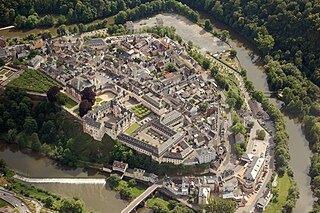
Limburg an der Lahn is the district seat of Limburg-Weilburg in Hesse, Germany.

Febronianism was a powerful movement within the Catholic Church in Germany, in the latter part of the 18th century, directed towards nationalising Catholicism, restricting the power of the papacy in favour of the episcopate, and reunion of dissident churches with the Catholic Church. Its thrust broadly corresponded to that of Gallicanism in France. Friedrich Lauchert describes Febronianism, in the Catholic Encyclopedia, as a politico-ecclesiastical system, ostensibly purposed to facilitate reconciliation of Protestant entities with the Catholic Church by curbing the Holy See's power.

Johann Nikolaus von Hontheim was a German historian and theologian. He is remembered as Febronius, the pseudonym under which he wrote his 1763 treatise On the State of the Church and the Legitimate Power of the Roman Pontiff and which gave rise to febronianism.

Count John VII the Middle of Nassau-Siegen, German: Johann VII. der Mittlere Graf von Nassau-Siegen, official titles: Graf zu Nassau, Katzenelnbogen, Vianden und Diez, Herr zu Beilstein, was since 1606 Count of Nassau-Siegen, a part of the County of Nassau, and the progenitor of the House of Nassau-Siegen, a cadet branch of the Ottonian Line of the House of Nassau.

Prüm Abbey is a former Benedictine abbey in Prüm, now in the diocese of Trier (Germany), founded by the Frankish widow Bertrada the elder and her son Charibert, Count of Laon, in 721. The first abbot was Angloardus.

Lahnstein is a verband-free town of Rhein-Lahn-Kreis in Rhineland-Palatinate, Germany. It is situated at the confluence of the Lahn with the Rhine, approximately 6 kilometres (3.7 mi) south of Koblenz. Lahnstein was created in 1969 by the merger of the previously independent towns of Oberlahnstein on the south side of the Lahn and Niederlahnstein on the north side. In 2020, it had a population of 18,030.

Weilburg is, with just under 13,000 inhabitants, the third biggest town in Limburg-Weilburg district in Hesse, Germany, after Limburg an der Lahn and Bad Camberg.

Gregory of Utrecht was born of a noble family at Trier. He became a follower of Saint Boniface, who sent him to study at the Monastery of Saint Michael at Ohrdruf. He then accompanied Boniface on his missionary journeys. In 750, Boniface appointed Gregory abbot of St. Martin's Monastery in Utrecht. St. Martin's became a centre of learning and missionary activity. When, in 754, Eoban left to accompany Boniface on their last missionary trip, Gregory was tasked with administering the diocese of Utrecht, which he did faithfully for the next twenty-three years until his death in 776.
Limburg Chronicle, or Festi Limpurgenses, is the name of a German chronicle that was probably written by Tilemann Elhen von Wolfhagen after 1402. It is a source for the history of the Rhineland between 1336 and 1398, but is perhaps more valuable for the information about German manners and customs, and the old German folksongs and stories which it contains. It has also a certain philological interest.

The Duchy of Nassau was an independent state between 1806 and 1866, located in what is now the German states of Rhineland-Palatinate and Hesse. It was a member of the Confederation of the Rhine and later of the German Confederation. Its ruling dynasty, now extinct, was the House of Nassau. The duchy was named for its historical core city, Nassau, although Wiesbaden rather than Nassau was its capital. In 1865, the Duchy of Nassau had 465,636 inhabitants. After being occupied and annexed into the Kingdom of Prussia in 1866 following the Austro-Prussian War, it was incorporated into the Province of Hesse-Nassau. The area today is a geographical and historical region, Nassau, and Nassau is also the name of the Nassau Nature Park within the borders of the former duchy.

Saint Erhard of Regensburg was bishop of Regensburg in the 7th century. He is identified with an Abbot Erhard of Ebersheimmunster mentioned in a Merovingian diploma of 684. Ancient documents call him also Erard and Herhard.

Villmar is a market village and municipality in the Limburg-Weilburg district in Hesse, Germany. The community is the centre for quarrying and processing the so-called Lahn Marble.

The Diocese of Limburg is a Latin Church diocese of the Catholic Church in Germany. It belongs to the ecclesiastical province of Cologne, with metropolitan see being the Archdiocese of Cologne.
Adrian and Peter von Walenburch (born at Rotterdam were both auxiliary bishops of Cologne, and Dutch Roman Catholic controversial theologians.
The Countship of Isenburg-Limburg was a state of the Holy Roman Empire in the 13th and 14th centuries, based around the city of Limburg an der Lahn in modern Hesse, Germany.
Gerlach V of Isenburg-Limburg, also called Gerlach II "the Elder" of Limburg, was Count of Isenburg-Limburg. He reigned between 1312 and 1355 as Lord of Limburg an der Lahn, and the head of the House of Limburg. The chronicler Tilemann Elhen von Wolfhagen describes him, in his pre-1402 Limburger Chronicle, as a virtuous nobleman and a bright poet in German and Latin.
Gerlach VI of Isenburg-Limburg, also known as Gerlach III of Limburg, was Count of Isenburg-Limburg and Lord of Limburg an der Lahn. He succeeded his father Gerlach V in 1355. In 1356, he married Elisabeth of Falkenstein.

Ottilie of Katzenelnbogen, was by marriage Margravine of Baden-Baden.
Johann Ludwig von Hagen was a German clergyman who served as Archbishop and Elector of Trier from 1540 until his death in 1547.

Johann Hugo von Orsbeck (1634–1711) was the Archbishop-Elector of Trier from 1675 to 1711.












